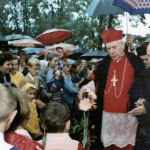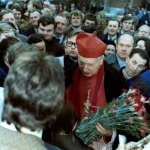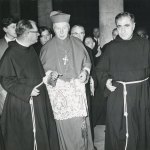On Sunday, September 12, 2021, Stefan Cardinal WYSZYŃSKI, Primate of Poland (1901-1981), will be raised to the altars and proclaimed Blessed. It is worth learning more about this exceptional figure. He led the whole Church of Poland during the difficult period under communism and he did so with the courage and wisdom that springs from the Gospel. However, more than that, he was a “humble Franciscan Tertiary” and, moreover, drew abundantly from the spiritual well of St. Maximilian Maria KOLBE.
Primate of the Millennium
Stefan Cardinal WYSZYŃSKI was born on August 3, 1901, in Zuzela, on the Bug River in Poland. After passing his final exams, he entered the major seminary in Włocławek and was ordained a priest on August 3, 1924. For four years he studied at the Catholic University of Lublin, earning a doctorate in canon law. During 1929-1930, he furthered his education in Western Europe. After returning to Poland, he became a professor of social sciences at the seminary in Włocławek and editor of the theological journal “Ateneum Kapłańskie” (Priestly Athenaeum).
During the Second World War, he carried out his pastoral ministry clandestinely in various parts of Poland. For example, he would secretly preach spiritual retreats for various social groups. Immediately after the war, he returned to the Diocese of Włocławek to organize the seminary and to devote himself to editing and publishing. On March 4, 1946, Pope Pius XII appointed him Ordinary of Lublin. On May 12, 1946, he was ordained a bishop by the laying on of hands of His Eminence, August Cardinal HLOND, Primate of Poland. The ordination took place in Jasna Góra, Poland. For his episcopal motto, he chose the words Soli Deo (to God alone). On November 16, 1948, he was appointed Metropolitan of Gniezno-Warsaw and Primate of Poland, as well as president of the Polish Bishops’ Conference.
He began his service as Primate under extremely difficult conditions due to the atheist, totalitarian regime that was then in power. Pope Pius XII, appreciating his work and apostolic efforts, appointed him a member of the College of Cardinals during the consistory of January 12, 1953. However, the communist state authorities would not allow him to go to Rome. On September 25, 1953, he was arrested and spent more than three years in various detention centers: Rywałd Królewski, Stoczek Warmiński, Prudnik, and Komańcza.
After his release, he resumed the service of Primate with renewed enthusiasm and devotion, implementing the great pastoral programs he had conceived and worked on during his imprisonment. His “Vows of Jasna Góra of the Polish Nation” (“Jasnogórskie Śluby Narodu Polskiego”), emphasized remaining faithful to God, the Church and her pastors, as well as fighting against national vices and developing social virtues (1956). In 1957, he started the pilgrimage of the copy of the miraculous painting of Our Lady of Częstochowa throughout all the parishes of Poland. He began the Great Novena, that is, a nine-year period (1957-1965) in order to prepare for Poland’s Millennium of Christianity and to promote social and moral renewal. He instituted the act of total consecration of the Polish nation to the Mother of God (macierzyńska niewola or “maternal slavery”) appealing for the freedom of the Church in Poland and in the world; and, finally, he launched the celebration of the Millennium of the Baptism of Poland (1966).
Cardinal WYSZYŃSKI took part in all the sessions of the Second Vatican Council (1962-1965), and involved the whole Polish Church in the work of the Council, introducing the “Conciliar Prayer Vigils with Mary.” At Cardinal WYSZYŃSKI’s request, Pope Paul VI proclaimed Mary as the Mother of the Church (1964). On September 5, 1971, in keeping with this spirit, he consecrated the whole human family to Mary, Mother of the Church, in Jasna Góra. His devotion to Mary is well known, as are the words he often repeated: “I have staked everything on Mary.”
He stood firmly for human and national rights during social conflicts in his country. He led the Church victoriously through the difficult experience of communism. He is considered one of Poland’s greatest figures of the 20th century. Posterity records him as the father of the nation, an outstanding statesman of great moral authority, and above all, as the “Primate of the Millennium,” because, as it is said, “God gives us such a father, pastor and primate once in a thousand years.”
He died on May 28, 1981, in Warsaw.
Franciscan Tertiary
“My dear brothers, allow me to call you such, although I am a humble member of the Third Order. I am happy to be among you, Most Reverend Fathers and Members of the General Curia of the Friars Minor Conventual, a well-deserving Order.” This was how Cardinal Stefan WYSZYŃSKI began his speech when, on October 24, 1970, he visited the General Curia of the Conventual Franciscan Order in Rome. In these words we can read something more—the deep feeling he had for our religious community.
He became a Franciscan Tertiary while he was at the seminary in Włocławek (1920-1924). Moreover, it should be said, because perhaps only a few people know it, that he was a faithful follower of the Poverello of Assisi. This is a little-known topic that requires more in-depth study by experts on his life and spirituality.
He was never publically boastful about his membership in the Third Order of St. Francis of Assisi. Instead, he emphasized his connection and closeness with those who live according to the spirit of the Franciscan Rule: “As a Franciscan Tertiary, I feel in spiritual communion with the great Franciscan Family, a family which brings together a large number of men and women religious as well as lay tertiaries from around the world” (1959). He took pride in being a member of the Third Order Regular: “God has allowed me to fall in love with the wonderful model of St. Francis. I have been a Franciscan Tertiary since my days in the seminary” (1971). He also felt a strong spiritual connection to the cradle of the Franciscan Order: “I thank you with all my heart for your prayers for my intentions at the tomb of St. Francis in Assisi. I must confess that I think I am there almost every day, because it is my habit to have recourse to my patron saint of the Third Order, an Order to which I have belonged since I was in the seminary” (1974).
At this point, it should be noted that despite the restrictions of his day, the Primate often meditated and immersed himself in the thought of St. Francis. He knew a lot about the life of the Saint of Assisi. One even gets the impression that his knowledge in this far exceeded that of the average Franciscan friar. Personally, he drew deeply from the spiritual well of St. Francis! He was simply fascinated by his patron saint. Here is just one of his observations: “The liturgy of the Mass of St. Francis seeks to unveil the truth: Francis reads and actualizes the Gospel, and precisely because of this he is today, contemporary, alive, close, and in our midst” (1976). The example and teachings of the Saint of Assisi are still relevant today; they have lost none of their value. He was a preacher of the Gospel and remains so to this day, not only through his disciples and his religious families, but above all as shown today through his fruits of Christ’s perfect love. He is therefore an ideal and a model for our times and a figure we very much need in our day!
Moreover, all Franciscanism today, according to the cardinal, is “strangely suggestive” (1981). The cardinal saw in the Franciscan movement a real possibility for the rebirth of the Church and the world. At the same time, he wanted to renew Franciscan spirituality itself, which was so vital for all of Christianity. He recognized the great role of the Rule of St. Francis in the life of the Church and wished, with the same zeal as the founder, that “Franciscan ideals would be realized and Franciscan action be applied in modern times with the fullness of the Franciscan spirit” (1959). This is why the Franciscan Families have such an important task, because they are the heirs of the concept of moral, social and economic renewal through the spirit of St. Francis. The cardinal wanted “life in our homeland to be more Franciscan, more evangelical and more Christ-like” (1976).
The Primate of the Millennium was a true Franciscan Tertiary!
A Soldier of the Immaculata
When reviewing the life of Cardinal Stefan WYSZYŃSKI, it seems insufficient to say that he cherished, and was close to, St. Maximilian Mary KOLBE. In a way, Cardinal WYSZYŃSKI modeled his life on this eminent figure and on his ideas and his forward-looking vision of Christianity in our time. Here, we must add something particularly important: During the cardinal’s ministry as Primate he continued the apostolic mission of Father KOLBE and promoted it throughout the Church of Poland. The “great pastoral programs” he carried out, especially the preparations for the Millennium of Christianity in Poland (then communist), which he undertook with great vigor, and his other actions aimed at strengthening religious life, were all inspired by the Marian spirit of Father Maximilian, a spirit which was the fruit of his Marian devotion: “Believe me, it is really so! I am deeply convinced that one could courageously travel the paths he indicated” (1962). Through his ‘great works,’ Father Maximilian taught the nation to observe a deeper reverence for the Immaculate Conception and “laid the foundations upon which the Polish episcopate would later built its pastoral programs.” The bishops of Poland, who “in their work are today are model Soldiers of the Immaculata” (1971), “were very interested in his vision….During difficult and seemingly hopeless times, when we did not know how to save the Church from atheization and moral decay, we were inspired…by the example of the life, work and heroic death of Father Maximilian Maria KOLBE” (1979). His mission for the Church and for the world turned out to be “prophetic.” He was a “prophetic visionary” (1971), who became an eloquent sign for the difficult times during the war and postwar period.
Our great cardinal, being a man with a deep interior life, had from the very start of his service as Primate, turned to the Servant of God, Father Maximilian KOLBE, to implore his heavenly intercession. The cardinal’s simple and open admission of this is heartwarming and gives us pause to think. He wrote: “I recently received a photograph of Father KOLBE… Every day, when I leave my room, I go to the chapel and gaze at this photograph. Kissing Father KOLBE’s feet, I pray that he might obtain strength and power for me, so that the commitments of the holy Church in Poland may be carried out according to the will of God” (1951). During the cardinal’s time in prison, he prayed “very often” imploring the intercession of Father Maximilian, because he trusted that he still had a great task to perform in our country and at the same time he believed in his extraordinary power that flowed throughout Poland (1956). He was convinced that Father Maximilian KOLBE could be a source of great spiritual help (1960). In another statement the cardinal said: “Personally, I always entrust the most difficult problems to Father Maximilian” (1960). He constantly carried in his heart “a deep feeling of gratitude toward the Soldier of the Immaculata” (1962).
Where do we find the origins and sources of the boundless reverence our Primate had for St. Maximilian? The cardinal himself “admitted” that during the pre-war period, when he thought he was “a big man,” he was “an enemy of Niepokalanów.” But later, when he “became a terribly small man,” he realized his mistake (1969). He did not hesitate to say frankly and from the depths of his soul, that “during his life he admired the works of Father KOLBE” and followed their extraordinary development (1951). “I was always interested in this extraordinary phenomenon on the landscape of religious life in Poland, namely, Niepokalanów (City of the Immaculate), the ‘Knight of the Immaculate,’ the Militia of the Immaculata, and that ‘leap’ of the Franciscan spirit—the Japanese Niepokalanów” (1957). The cardinal explored almost every aspect of this “extraordinary phenomenon.” He was incredibly well-informed about the life, activities and spirituality of Father Maximilian. He had amassed a vast and rich store of knowledge about him. He meditated deeply on his ideas and, like few others, he understood the spirit of KOLBE! He said of him: “His whole life, his difficulties, his sacrifices and his efforts, all add up to something that today amazes us, cheers us up, makes us reflect and urges us to follow in his footsteps” (1972). Therefore, “Father Maximilian is extremely close to us; he exerts a constant influence on us; he continues to convince and conquer us all over again” (1968).
The cardinal stressed that today “there is a great need for soldiers of the Immaculata” and that Father KOLBE “is calling all of us to knighthood” (1957). He himself accepted this call and, as he publicly stated, he entered with his spirit into the ranks of the Militia of the Immaculata. The Primate always used this original name of the Militia of the Immaculata: “Milicja Niepokalanej.” One should also remember that during the early years after the war, the decrees and ordinances issued by the Communist government had dissolved Poland’s ecclesiastical associations and made life difficult). He also swore this oath of fidelity: “To you, Servant of God, Father Maximilian, we vow to follow in your footsteps, to revive our deep faith in the power of the Immaculata and to carry on your work in the homeland of the Mother of God and Mother of the Church, the Queen of Poland, Our Lady of Jasna Góra” (1967). He said this during the celebration of the 50th anniversary of the foundation of the Militia of the Immaculata, which took place in Niepokalanów.
He was convinced that “the Militia of the Immaculata is necessary for Poland” (1972), because he was aware of “how well it has worked, how many victories over numerous souls [it has brought about], how many noble religious vocations, how many impulses for conversion, how many feelings of noblest chastity, faith, and love! Who can calculate it? If today we wanted to write the chronicles of the Militia of the Immaculata, we would have to undertake spiritual introspection in order to peer deeply into souls, because these stories are written with the finger of God’s grace, with the participation of the Mediatrix of All Graces, on every soul, in every heart, and in every thought” (1957).
He remembered, in a special way, the joyful day he visited the Conventual Franciscan College on Via San Teodoro in Rome (1958), the place where “in the name of Mary Immaculate, Maximilian KOLBE, full of hope and living faith, began the work of the Militia of the Immaculata in 1917.” During that particular visit, he was struck by the strange inner courage of this man, who, after “seeing the immensity of the danger threatening the world and the Church, which come from unbelief and satanic powers, and seeing the conspiratorial forces of the powers of darkness turning against Christ, sought means of defense. He found them in Mary Immaculate” (1967).
The Primate called Father Maximilian “a true knight of the Immaculata.” His Eminence, Józef Cardinal GLEMP, who had been Cardinal WYSZYŃSKI’s long time secretary and directly succeeded him as the Primate of Poland, had this to say about his predecessor: “It can be said that this new soldier of the Immaculata, this slave of Mary, who guided Poland along the path of St. Maximilian towards a better tomorrow, is also Cardinal Stefan WYSZYŃSKI” (1994).
The Primate of the Millennium was a true soldier of Mary Immaculate!
“Your Brother”
During one of his many visits to Niepokalanów, the Primate finished a message he wrote in the visitors’ book by saying: “Bless you—Your brother—Stefan Cardinal WYSZYŃSKI, Primate of Poland” (1977). He wrote this during the celebration of the 50th anniversary of the founding of the Niepokalanów Friary.
“Your brother.” In a family, no one chooses to be a brother; he either is one or he isn’t. It is very nice that in our religious spiritual family we had such a great, outstanding and wonderful brother! He was “a brother to us all” and remains so today. He lived the spirituality of St. Francis of Assisi and St. Maximilian Maria KOLBE. Among his many Franciscan suggestions, he left us with these encouraging words: “If love was possible for Francis of Assisi and Maximilian Mary KOLBE, that means it’s possible for anybody” (1976).
Friar Sławomir GAJDA


























